Green Shoots of Stock Market and Economic Recovery?
Stock-Markets / Stocks Bear Market Apr 11, 2009 - 12:07 PM GMTBy: John_Mauldin
 Is That Recovery We See?
Is That Recovery We See?
Those Wild and Crazy Analysts
The Shadow Inventory of Homes
Commercial Real Estate Starts a Long, Slow Slide
P/E Ratios Go Negative!
The Effect of Earnings Surprises
Corporate Earnings and Recovery in Recessions
The Implosion in Social Security
The market, we keep hearing and reading, is telling us that there is recovery around the corner. And pundits point to data that seems to suggest the worst is behind us. The leading economic indicators, while still down significantly, seem to be in the process of bottoming. There is a large amount of stimulus in the pipeline. Mark-to-market has been modified. Housing seems to be finding a bottom, if you look at the rise in sales from January. And so on.
In this week's letter, we look at what past recoveries have looked like in terms of corporate earnings; and we look at the continued slide in earnings on the S&P 500, which has a negative price-to-earnings ratio looming in future months (yes, that is not a typo, we have an unprecedented earnings multiple). We take a peek at housing and foreclosures. There is just so much bad news out there (like continued unemployment) that it just has to get better, doesn't it? This should make for an interesting letter.
Is That Recovery We See?
This week the market seemed to like financial stocks and was buoyed on news that Pulte Homes would buy Centex to create the largest US homebuilder. And with banks having some room to adjust their writedowns as mark-to-market is modified, the market saw significant increases in the financial sector. Everywhere I keep hearing the old saw that the market predicts a recovery about six months out, so won't we see a recovery in the fourth quarter of 2009?
If you look at earnings estimates for 2009, that is what is suggested. Bloomberg reports that profits at S&P 500 companies probably fell 38% on average in the first quarter. The stretch of quarterly declines is the longest since at least the Great Depression, data compiled by S&P and Bloomberg show.
Earnings may drop 31% in the second quarter and 18% in the next before gaining 74% in the last three months of the year, analysts predict. Banks are projected to account for all of the rebound in the final quarter. Without financial companies, the gain turns into a 5% decline, the data show.
The above estimates are based on operating earnings, not as-reported earnings. Long-time readers know that operating earnings are actually earnings before interest and Bad Stuff. As-reported earnings are what companies actually report on their tax reports, and as a gauge of profitability they are much more reliable. Before the mid-'90s the difference between operating and as-reported earnings was typically quite small. Then companies found they could play the market if they played games with their operating earnings.
Operating earnings typically do not take into account one-time, nonrecurring events. The number of items which get classified as "nonrecurring" has mushroomed to the point where projected operating earnings for 2009 are more than double the estimates of as-reported earnings. Operating earnings for 2008 were almost three times actual, or as-reported, earnings. We certainly seem to have entered an era of really bad one-time events, which just keep on coming and coming. As recently as 2006, there was less than a 10% difference between the two. In some quarters it was only 5%. A far cry from today's 100%-plus.
Those Wild and Crazy Analysts
Analysts, who as a group have been egregiously bad at predicting earnings of financial stocks for the last two years, would have us believe they are due for a large rise in the 4th quarter. Let's visit those assumptions for a few minutes.
They contend that much of the bad news in the subprime-loan and housing market has been written off. And one would have to admit that a lot has been; and with the relaxation of mark-to-market, there may indeed be some truth to that suggestion. But there are still some issues that remain for housing. Take a look at the graph below. (Not sure where it is from, as it was sent to me, but I have seen the same data elsewhere.) Notice that monthly mortgage-rate resets declined markedly in 2009 from 2008, but are expected to rise again in 2010 and 2011. There is still some heartburn in the mortgage market.
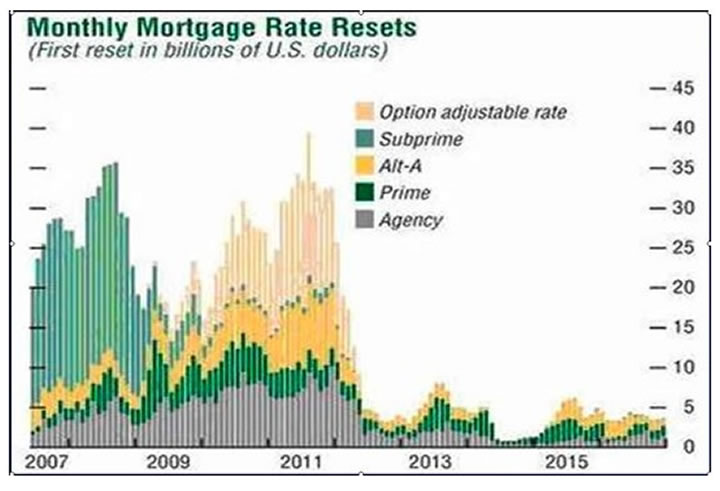
The Shadow Inventory of Homes
And foreclosures keep climbing, though some point to that fact that they seem to be leveling off. However, a strange thing is happening. We are seeing what is being called a "shadow inventory" of foreclosed homes.
"We believe there are in the neighborhood of 600,000 properties nationwide that banks have repossessed but not put on the market," said Rick Sharga, vice president of RealtyTrac, which compiles nationwide statistics on foreclosures. "California probably represents 80,000 of those homes. It could be disastrous if the banks suddenly flooded the market with those distressed properties. You'd have further depreciation and carnage." (San Francisco Chronicle)
A Realty Trac survey found that only 30% of foreclosures were listed for sale in real estate listings like the MLS (Multiple Listing Service). Add in homes that people would like to sell but simply can't find buyers for, and must either hold or rent, and the unsold inventory numbers that are public are likely far below actual available homes.
Might some homes in foreclosure be held off the market because banks eventually want to negotiate with the homeowner? Possibly, but other surveys show that anywhere from 30-40% of homes in the foreclosure process in many areas are actually already vacant. There is no one with whom to negotiate.
Typically a foreclosed home sells within a few weeks, as banks take the first "reasonable" offer. But it normally takes about three months from foreclosure to when the home is put on the market -- it takes a few months to get a home ready. But surveys show it is taking a lot longer now, and many homes have not made it onto the market, even as more homes are being foreclosed each month.
The Chronicle suggests several factors may be at work. First, there is the "pig-in-the-python" problem. There are just so many homes that it is hard to get them onto the market and sold. Normally there are about 160,000 homes a year in foreclosure sales. We are now seeing 80,000 a month, or six times normal levels, and rising.
Second, lenders could be deferring sales to put off having to acknowledge the actual extent of their losses. "With banks in the stress they're in, I don't think they're anxious to show losses in assets on their balance sheets," one observer said.
Finally, banks may not want to flood the market with foreclosures, driving prices down even more. They are simply managing their assets so as to recover the most capital they can.
Given that the graph above says there will be more mortgage misery as large numbers of mortgages reset in the next two years, and given the unknowable nature of the losses, it is somewhat optimistic to think financial profits will rise by 74% in the fourth quarter. But it gets worse.
Commercial Real Estate Starts a Long, Slow Slide
We are now starting to see some real deterioration in traditional bank lending. Delinquencies on home equity loans are rising rapidly. The American Banking Association released a composite index of eight different types of consumer loans, and the delinquency rate on this 35-year-old composite jumped to a record high of 3.22%.
The above reflects 4th-quarter data. As unemployment is up 2% since then and is rising, it is more than reasonable to assume that we will see another record rise in delinquencies this quarter. With unemployment headed to over 10% and maybe 11% from today's 8.5%, delinquencies are likely to continue to rise for the entire year.
David Rosenberg reports that "The National Federation of Independent Business found in a poll that 28% of small firms said they had a line of credit or credit card limit cut back in the second half of last year; 69% stated they are facing worse terms. A new FICO study found that 11% of US consumers -- 22 million people -- have had their credit lines cut or accounts closed even though they have been paying their bills on time and retain a solid rating." This is certainly not good news for those who expect a positive 4th quarter. Cutting credit to small business, the engine of job growth in the US, is hardly a prescription for a growing economy.
Commercial mortgages are in trouble. S&P has warned they may cut ratings on $97 billion in commercial-mortgage asset-backed debt. The country's 10 biggest banks have $327.6 billion in commercial mortgages, according to regulatory filings. A projected tripling in the default rate would result in losses of about 7% of total unpaid balances, according to estimates from analysts at research firm Reis Inc. (Bloomberg)
I think, given the track record of the analysts who project a 74% rise in earnings for financial stocks in the 4th quarter of this year, that we should remain a tad skeptical. And speaking of earnings, let's go to the S&P web site and see how things are progressing.
But first, let's look at just how badly analysts blew it in estimating 2008 earnings. In the table below we see that as recently as October 15 they were estimating AS-REPORTED earnings to be $54, down from $92 when I first saw the 2008 estimates. There were only two months to go in 2008. So, what are the actual 2008 earnings? Down to $14.88!!!
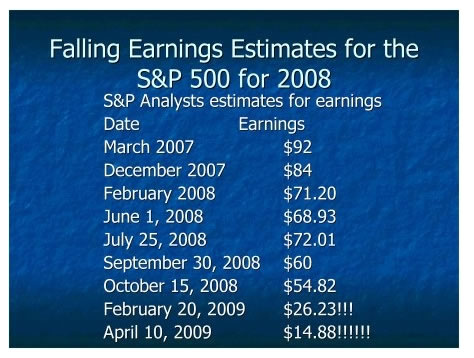
Not exactly a record to inspire confidence. So, how are we doing in 2009? We see the same pattern. There is a clear deterioration in earnings estimates. Yet, even with the ever lower estimates, they are still projecting nearly a doubling from 2008. Care to make a wager as to what the estimates will look like in a few quarters? Think we will see earnings rise?
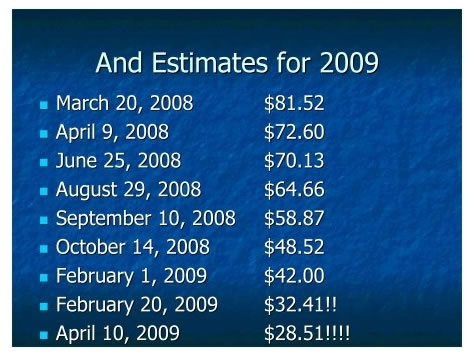
P/E Ratios Go Negative!
When we last visited the S&P web site a few weeks ago, the P/E ratio for the quarter ending September 30 was around 181. I must confess that when I looked at it today, as jaded as I am, I was shocked. You can see the numbers for yourself at http://www2.standardandpoors.com/...
The P/E ratio for the end of the second quarter is 1944 (not a typo). The losses of the 4th quarter wipe out almost all earnings for the 12 months ending June 30. But by the end of the 3rd quarter, the estimated P/E ratio has dropped to a (negative) -467. That has never happened. We have never seen negative earnings over a 12-month period since WWII. (I don't have data for the Depression era.)
Then as the negative earnings of the 4th quarter of 2008 drop off, we see the estimated P/E ratio rise back to 30, which is quite high. However, if actual earnings come in lower, as I think they will, the P/E ratio will rise and/or the market will fall as negative earnings surprises just keep on coming.
The Effect of Earnings Surprises
As William Hester of Hussman Funds writes in a recent article, the rise and fall of the stock market closely correlates with earnings surprises. Look at the following chart. (You can see the whole article at http://www.hussmanfunds.com/rsi/econsurprises.htm . I highly recommend it.)
As Hester writes, "To track the trends in economic performance, we keep an ongoing tally of how data is announced relative to expectations -- a method of analysis originally inspired by Bridgewater Advisors . Economic data that surpasses expectations gets added to a 3-month running total. Data that comes in weaker than expected gets subtracted. A rising line means that economic data is generally coming in above expectations, while a falling line means that the data has disappointed. A descending line could be the result of an economy that is not expanding as quickly as economists predict or -- like in 2008 -- it could be the result of an economy that is contracting at a faster rate than expected.
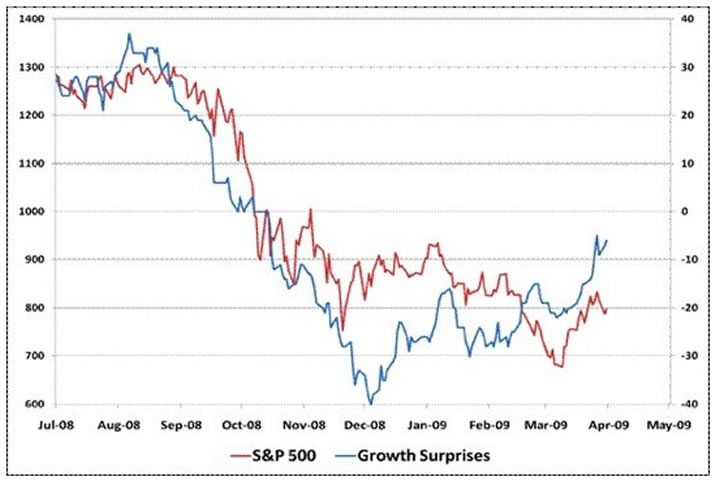
"... Much of the excitement in the stock market -- at least that is related to the current performance of the economy -- seems to be centered on an economy that is performing less badly than expected. The risks here seem to be that if the trends in data surprises change, so could investors' attitudes toward stocks that are currently overbought on a number of measures.
"... If the high correlation between stock prices and data surprises holds, the recent rally in stocks might be tested. Even if the economy has bottomed, it's very likely that the eventual recovery will prove to be uneven, causing the flow of positive surprises to be uneven. During these periods, the risks to stocks will be greatest when the market is overbought and investors have priced in high expectations of positive data surprises continuing."
The projections of many market analysts assume that we will have something that will look like a normal recovery. I have objected that that could be a very bad assumption, since we are not having a normal recession. This is already a very lengthy recession, and is just going to get longer. As I will note below, there are reasons to think we could see a mild recovery late this year, only to dip back into recession next year.
Corporate Earnings and Recovery in Recessions
Next, let's look at a very interesting chart sent to me by one of my readers, Chad Starliper of Rather and Kittrell in Knoxville, Tennessee. It shows all the cumulative drops in earnings from major peaks, along with the recovery paths. What is interesting is the divergence between the pre- and post-WWII periods. Our experience since 1945 is one of rather quick recoveries, averaging about 3-4 years until earnings rise above the old highs.
The thicker black line shows a drop of 69.2% from peak earnings since 2007. Prior to World War II, it took 12-20 years for earnings to recover. Earnings are still dropping. As I will point out in the next few e-letters, we live in a world (not just the US) that is in a deep recession. There is massive deleveraging and deflation. The recovery is going to be quite slow, and that portends a slow recovery in earnings, which suggests protracted churning in the stock market. (By the way, for those of you who print out this letter, the next graph will be hard to read if it is not in color.)
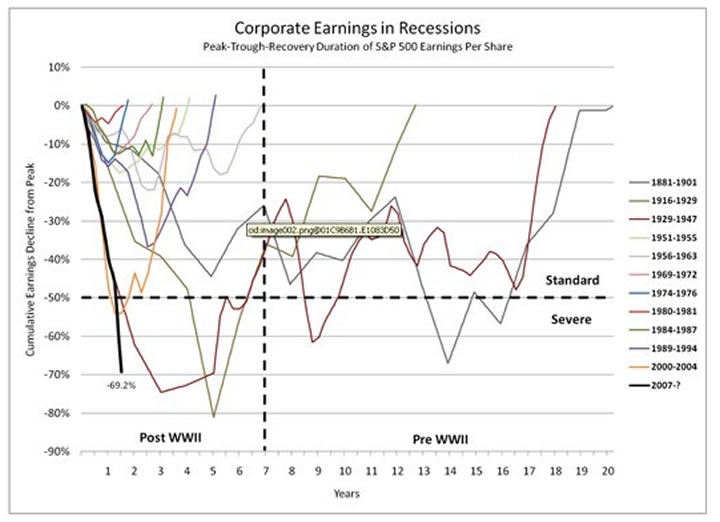
Even ignoring the disastrous 4th quarter of 2008, what if earnings drop by 80% or more, which is quite possible? That means they have to rise by 400% to get back to new highs. That could take some time. Even if they could rise at an unlikely 24% a year, it would take six years to see new highs. Look at what a mountain corporate earnings must climb.
Consumers are retrenching, and savings rates are likely to rise for at least 3-4 years, back to 7% or more, leaving consumer spending not at 70% of US GDP but closer to 63%. That will be a rather large adjustment, and will mean that a lot of productive capacity will have to be closed or allowed to lie in disuse for a long time. We just built too many strip malls and car factories and restaurants. It is going to take some adjustments.
Further, the Democratic Congress and the Obama administration are going to enact the largest tax increase in history in 2010, just as the economy is barely recovering. The Bush tax cuts go away, because the Republicans could not make them permanent when they had the chance. We are going to pay for that with a likely dip back into a recession in 2010, or at the very least a prolonged weak economy.
The Implosion in Social Security
And then there is the last piece of data I want to bring to your attention, which is the most troubling of all. Everyone knows that the government spends the Social Security surpluses on current needs, "borrowing" the money and putting it into a "Social Security Trust Fund," which is basically just US debt we owe to the trust fund. In other words, there is no trust fund with anything other than paper debt. It is accounting legerdemain.
Everyone assumed that the real problem would come sometime later next decade, when there would no longer be surpluses. In 2008, the Congressional Budget Office (CBO) projected there would be $703 billion in surpluses from 2009-18. Recently, the CBO has revised those estimates downward. It now projects surpluses to be only $83 billion. Here is a table that was sent to me from a blog by Chris Martensen. ( http://www.chrismartenson.com )
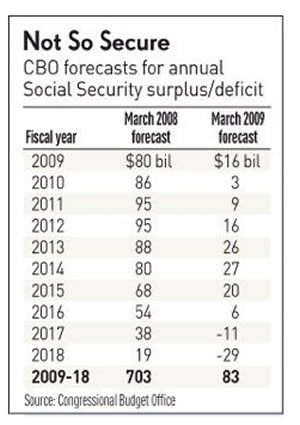
Writes Chris, "In the projections for the table above, the CBO has assumed no cost of living adjustments (COLAs) in 2010, 2011, or 2012 and a return to economic growth next year. If either of those assumptions proves wrong, the table above gets smoked to the downside."
Losing $700 billion (and likely a lot more) out of your budget projections is a huge blow to the US taxpayer. That money is going to have to be borrowed, or spending reduced. But the plans are for huge increases in spending.
In one of the great ironies, the Democrats and the Obama administration are going to have to deal with the Social Security crisis, and soon. Bush tried to do so, and he got torpedoed from both sides of the aisle. Politicians just do not want to be seen doing anything to SS. Given the massive, multi-trillion-dollar deficits that are projected, the US is going to face some difficulty in borrowing to meet those deficits in the not-too-distant future. Is it 3 years? 4? 5? No one can say for certain, but that day is coming and it now appears much closer.
Let's say that US consumers do save 7%. That's almost a trillion a year. The trade deficit dropped to $26 billion last month, as imports continued to drop. That's another $300 billion that foreign central banks could recycle. The Fed could print a few trillion here or there without really pushing up inflation in today's deflationary world.
But there is a limit to continued $2-trillion deficits without the appreciable rise in interest rates that will be needed to attract buyers of Treasury bonds, which of course would increase interest-rate payments on the national debt, while also crowding out corporate and personal borrowing. This is not going to end well, and the end game is getting a lot closer.
All in all, the next few years are going to be a very difficult environment for corporate earnings. To think we are headed back to the halcyon years of 2004-06 is not very realistic. And if you expect a major bull market to develop in this climate, you are not paying attention.
The original question was "Is that recovery we see?" I think the answer is no.
Copenhagen, London, Newport Beach, etc.
Last week's Strategic Investment Conference was the best we have ever had. Many attendees said it was the best investment conference they had ever attended. We are transcribing speeches and will make some of them available over time.
The Richard Russell Tribute Dinner was a great success. We had video crews there as well as photographers, and intend to allow those who wish they could have been there to see part of the evening. It was a very emotional evening, and I want to thank the roughly 450 people who came from all over the world just to pay tribute to one of the true wonders of the investment-writing world.
I leave Monday evening for Copenhagen, where I will meet with Tom Fischer of Jyske Bank, and then day-long, back-to-back board meetings with Niels Jensen of Absolute Return Partners, and back to London Wednesday night for more meetings.
I get back Friday in time to write the letter, then off the next Thursday to Orange County, where I will attend Rob Arnott's annual conference. More on that later. Back on Sunday, and then out Monday to the Charter Financial Analyst conference in Orlando, where I speak on the "state of the union" of the alternative investment world. Then I am home for awhile, and gladly.
We had 300 people in for the Strategic Investment Conference, and the staff of my partners and co-hosts, Altegris Investments, did a magnificent job making everything go smoothly. There were so many friends there, the only disappointment was that I did not have all the time I wanted to meet with everyone. It was like drinking from a fire hose for three days, but it was fun.
It's time to hit the send button, as all my kids are in town and most of us are going to have some dinner and then see the Dallas Mavericks play. Brunch on Easter, of course, with family and friends, and then the final day of the Masters to round out a perfect weekend. I have been watching some of it on ESPN, and seeing Augusta on high-definition TV is truly spectacular.
I hope your weekend will be as good as mine. Spend time with family and friends if you can. That time is an investment that will pay dividends forever, and doesn't run up the national debt. Well, a little bit, if you have to buy the tickets and pay for brunch for about 16. But that's what Dads are for.
Your starting to think about the end game more analyst,
By John Mauldin
John Mauldin, Best-Selling author and recognized financial expert, is also editor of the free Thoughts From the Frontline that goes to over 1 million readers each week. For more information on John or his FREE weekly economic letter go to: http://www.frontlinethoughts.com/learnmore
To subscribe to John Mauldin's E-Letter please click here:http://www.frontlinethoughts.com/subscribe.asp
Copyright 2008 John Mauldin. All Rights Reserved
John Mauldin is president of Millennium Wave Advisors, LLC, a registered investment advisor. All material presented herein is believed to be reliable but we cannot attest to its accuracy. Investment recommendations may change and readers are urged to check with their investment counselors before making any investment decisions. Opinions expressed in these reports may change without prior notice. John Mauldin and/or the staff at Millennium Wave Advisors, LLC may or may not have investments in any funds cited above. Mauldin can be reached at 800-829-7273.
Disclaimer PAST RESULTS ARE NOT INDICATIVE OF FUTURE RESULTS. THERE IS RISK OF LOSS AS WELL AS THE OPPORTUNITY FOR GAIN WHEN INVESTING IN MANAGED FUNDS. WHEN CONSIDERING ALTERNATIVE INVESTMENTS, INCLUDING HEDGE FUNDS, YOU SHOULD CONSIDER VARIOUS RISKS INCLUDING THE FACT THAT SOME PRODUCTS: OFTEN ENGAGE IN LEVERAGING AND OTHER SPECULATIVE INVESTMENT PRACTICES THAT MAY INCREASE THE RISK OF INVESTMENT LOSS, CAN BE ILLIQUID, ARE NOT REQUIRED TO PROVIDE PERIODIC PRICING OR VALUATION INFORMATION TO INVESTORS, MAY INVOLVE COMPLEX TAX STRUCTURES AND DELAYS IN DISTRIBUTING IMPORTANT TAX INFORMATION, ARE NOT SUBJECT TO THE SAME REGULATORY REQUIREMENTS AS MUTUAL FUNDS, OFTEN CHARGE HIGH FEES, AND IN MANY CASES THE UNDERLYING INVESTMENTS ARE NOT TRANSPARENT AND ARE KNOWN ONLY TO THE INVESTMENT MANAGER.
John Mauldin Archive |
© 2005-2022 http://www.MarketOracle.co.uk - The Market Oracle is a FREE Daily Financial Markets Analysis & Forecasting online publication.



